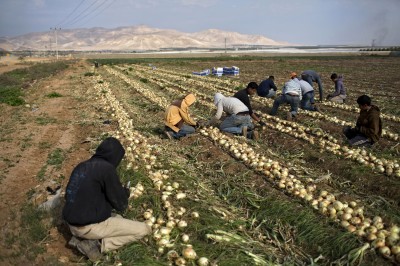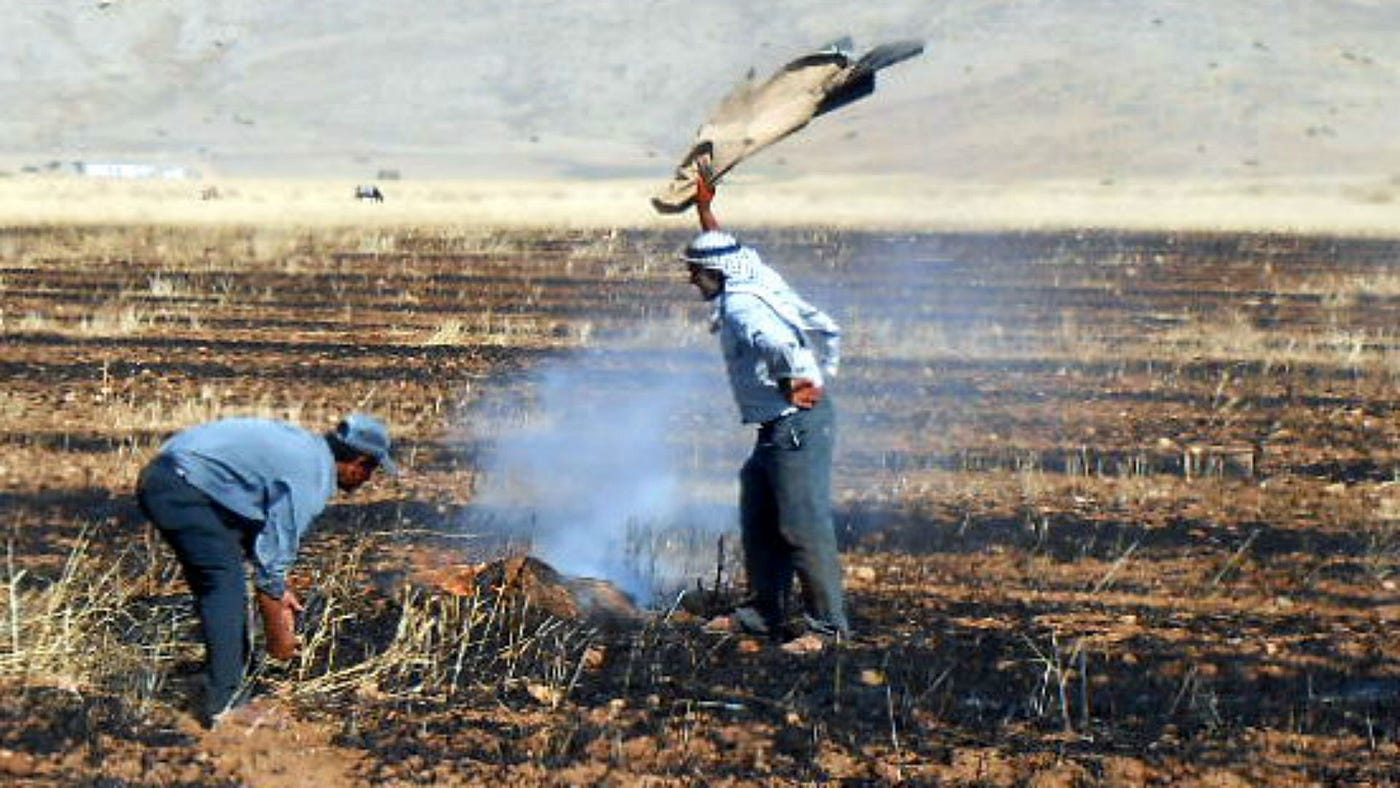Burning Gold: Israel’s Destruction of Jordan Valley Harvests

by Alice Gray
As Palestinian farmers harvest their cereal crops, a military exercise using live ammunition staged by the Israeli army is starting fires that are destroying thousands of dunums of farmland.
The Jordan Valley is a sea of gold: following the best winter rains the region has seen in decades, fields of wheat and barley ripple in the breeze, their heads heavy with grain that will sustain pastoralist communities and their animals through the long heat of the summer to come.
It is a bumper harvest this year, and the farmers are busy.
On the hillsides, tractors are at work harvesting the grain and cutting the straw. Some of the produce they keep for themselves and the rest they sell at market: an important source of cash income.
But not all crops make it to the storage barns or the market. In the past week alone, fires have been raging out of control across the region, burning up produce worth hundreds of thousands of shekels.
Palestinian farmers and activists say these fires were caused by the shells and munitions fired by the Israeli army in its training exercises, which began on May 3. The scale of this year’s “exercises” are unprecedented, involving hundreds of military vehicles, helicopters and tanks and approximately 2,000 military personnel.
“They could have had this training at any time — they could have done it when the wheat was green,” says Rashed Sawaftah, coordinator of the Jordan Valley Solidarity group (JVS).
“But they chose to do it now, when everything is ready to burn. Five communities have been told to evacuate their land, and there are fires starting all over the place.”
Ali Abu Khreish of Herbaiet al-Homra community said he was forced to leave farmland unprotected.
“They came at six in the morning and told us to get out,” he told al-Araby al-Jadeed. “We couldn’t return to our home until six in the evening, and we couldn’t send our children to school. We spent the whole day on the mountain by al-Hadidiya, in the sun and the wind. When we returned, our neighbour’s land had been burned.”
The sounds of explosions and the rattle of gunfire can be heard throughout the area, while helicopters whir overhead and heavy lorries rattle by, delivering tanks to Israeli military bases.
The Israeli army spokesperson says the families were evacuated for their own safety — and that the army has enlisted a special fire extinguishing squad to participate in the drill.
Yet the hillsides around Herbaiet al-Homra are scorched black where both crops and scrub have burned.
“It’s not just the crops that are important,” says Rashed Sawaftah. “If the scrublands burn, the farmers will have nowhere to graze their animals.”
Military presence and occupation
The Jordan Valley covers 30 percent of the land area of the West Bank, occupied by Israel since 1967. The area spans the length of the West Bank from north to south and comprises its entire border with Jordan.
Today there are more than 20 Israeli military bases in the Jordan Valley and 37 percent of the land is designated as “military training areas”.
Israel’s Prime Minister, Binyamin Netanyahu, has vowed that the Israeli army will remain in the Jordan Valley, regardless of any future agreement with the Palestinian Authority. Furthermore, he has stated that he regards the entire area as a “defined military zone”.
Depopulation and colonisation
Israel’s presence in the Jordan Valley does not end with its military bases.
An estimated 86 percent of the area is now controlled by 37 illegal settlements, which are home to around 10,000 Israeli settlers. The main economic activity of these colonies is agriculture, with much of their produce being exported — a multi-million dollar industry.
At the same time, Palestinian farmers in the area face enormous restrictions, including lack of access to water or electricity networks — either for their farms or for their homes; and the near-blanket denial of planning permission for building any kind of permanent structures (such as houses or rainwater harvesting cisterns), and attendant demolitions.
A total of 94 percent of applications for permission to build have been declined in recent years, according to the British charity Oxfam, while the UN Office for the Coordination of Humanitarian Affairs reports that 246 Palestinian structures were demolished in the Jordan Valley in 2014, leading to the displacement of 510 people.
The Palestinian population of the Jordan Valley has been falling ever since the occupation began in 1967, when, according to the Israeli rights group B’Tselem, more than 320,000 people were living there.
Now only 56,000 remain, and the poverty rate in their communities is double that of the rest of the West Bank.
A report issued by Human Rights Watch in April records that many families are dealing with this by sending their children to work in Israeli agricultural settlements, where they endure exploitative conditions — as none of Israel’s normal labour laws are enforced.
More than 1,000 Palestinian children, some as young as 11, are working 10–12 hour shifts in the extreme temperatures prevailing inside greenhouses (over 50 degrees Celsius in the summer) and taking home as little as 50 shekels a day or less (around $13), according to the report.
According to a World Bank report released in October 2013, if Israeli restrictions on Palestinian access to land and water resources in Area C were lifted, potential agricultural activities could add $704 million to the struggling Palestinian economy each year.
Water, water everywhere…
The Jordan Valley is relatively rich in water resources, yet one of the most crippling problems facing Palestinian communities in the area is access to water. Many communities remain unconnected to the network, and are forced to bring in water in tankers pulled by tractors to fulfill their needs.
Tankered water is about five times more expensive than piped water — costing 200–300 shekels for every 10 cubic metres according to farmers in Hadidiya and Homra. As a result, per capita water consumption for Palestinians living in Tubas governorate averages just 30 litres per person per day according to EWaSH, a coalition of development organisations focused on water.
By contrast, Israeli settlers in the same area have access to approximately 450 litres of water per person per day, supplied via pipelines from wells controlled by the Israeli water company Mekorot. Mekorot controls 28 wells in Palestinian territory, extracting 32 million cubic metres of water from under the occupied West Bank each year.
These wells and pipelines run over and around Palestinian communities and their farmland, but they are strictly off-limits — heavily fenced and under the surveillance of the ever-present military.
On May 6, al-Araby witnessed farmers in Hadidiya community using three tankers of water (valued at 600 shekels, about $160) to extinguish a blaze in a wheat field directly adjacent to a Mekorot pipeline — just a few hundred metres outside the agricultural settlement of Roi, which controls 20,000 dunums of land and has a population of fewer than 200.
According to eye-witnesses, the fire started when settlers set fire to an unregulated rubbish dump outside their gate.
As farmers and community members fought to put out the flames, two Israeli military vehicles passed by, but did not stop to help or make enquiries.
Ongoing struggle
“It’s been like this for over 20 years,” says Rashed Sawaftah. “Every year there is military training, and every year there are fires.”
The JVS and the Land Defence Commission have petitioned the diplomatic missions of EU member states to intervene and call upon Israel to suspend military training in civilian areas of the occupied West Bank on pain of sanctions — but to no avail.
Sawaftah accuses the military of using the training as part of a wider strategy to put pressure on people to leave their land, while Israeli army sources say the families are living illegally in an official firing zone.
Many farmers have seen their homes demolished several times already, but nevertheless, many remain determined to stay, and to rebuild again.
“We will not give up” one resident of Homra, nicknamed al-Zobaa [“The Storm”] for his years of steadfast resistance to displacement, told al-Araby.
“We will keep on resisting until we die, whatever they do and whatever it takes. I am not leaving my land.”
Copyright Alice Gray, Al-Araby 2o15


